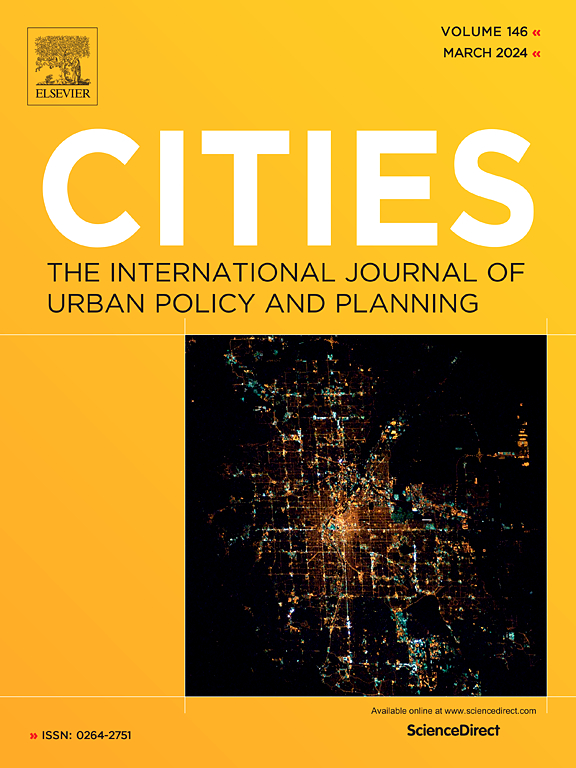Revitalizing urban industrial heritage: Enhancing public trust in government through smart city development and open big data analysis using artificial neural network (ANN) modeling
IF 6
1区 经济学
Q1 URBAN STUDIES
引用次数: 0
Abstract
This study shows how smart city development revitalizes urban industrial heritage (UIH) and traditional industrial areas, especially by fostering public trust in government through open big data analysis. Rapid urbanization and industrialization have led to the degradation of many old industrial areas, causing urban decay and environmental concerns. However, smart city technologies show new opportunities for rejuvenating these locations, transforming them into vibrant, sustainable, and livable environments. The research shows challenges faced by UIH, such as outdated infrastructure, pollution, and neglect, and explores how smart city technologies can enhance resource efficiency, mobility, connectivity, and the built environment. It indicates the potential of open big data analysis to foster transparency and accountability, thereby enhancing public trust in government efforts. Various international examples of smart city initiatives illustrate the benefits of these technologies, stressing the importance of community involvement to ensure the success and sustainability of revitalization efforts. Additionally, the study shows an artificial neural network (ANN) to analyze relationships among various parameters, showing its effectiveness in understanding complex functions, even with training data errors. By modeling the connections between aging infrastructure, pollution, and factors such as resource use and mobility, the research achieves high predictive accuracy. The study advocates for a holistic approach to urban revitalization that emphasizes social, economic, and environmental sustainability. It suggests that integrating smart city development with open big data analysis can transform urban industrial heritage into vibrant, resilient areas, effectively addressing 21st-century challenges and enhancing public trust in government initiatives.
振兴城市工业遗产:利用人工神经网络(ANN)建模,通过智慧城市发展和开放式大数据分析提高政府公信力
本研究展示了智慧城市发展如何振兴城市工业遗产(UIH)和传统工业区,特别是如何通过开放式大数据分析提高公众对政府的信任。快速城市化和工业化导致许多老工业区退化,造成城市衰败和环境问题。然而,智慧城市技术为这些地区的复兴带来了新的机遇,使其转变为充满活力、可持续发展的宜居环境。研究显示了 UIH 所面临的挑战,如落后的基础设施、污染和忽视,并探讨了智慧城市技术如何提高资源效率、流动性、连通性和建筑环境。报告指出了开放式大数据分析在促进透明度和问责制方面的潜力,从而提高公众对政府工作的信任度。智慧城市倡议的各种国际实例说明了这些技术的益处,强调了社区参与对于确保振兴工作的成功和可持续性的重要性。此外,该研究还展示了一种人工神经网络(ANN),用于分析各种参数之间的关系,显示出其在理解复杂功能方面的有效性,即使在训练数据存在误差的情况下也是如此。通过对老化的基础设施、污染以及资源使用和流动性等因素之间的联系进行建模,该研究实现了较高的预测准确性。该研究主张采用一种强调社会、经济和环境可持续性的整体方法来振兴城市。研究认为,将智慧城市发展与开放式大数据分析相结合,可以将城市工业遗产转变为充满活力和弹性的地区,有效应对 21 世纪的挑战,并提高公众对政府举措的信任度。
本文章由计算机程序翻译,如有差异,请以英文原文为准。
求助全文
约1分钟内获得全文
求助全文
来源期刊

Cities
URBAN STUDIES-
CiteScore
11.20
自引率
9.00%
发文量
517
期刊介绍:
Cities offers a comprehensive range of articles on all aspects of urban policy. It provides an international and interdisciplinary platform for the exchange of ideas and information between urban planners and policy makers from national and local government, non-government organizations, academia and consultancy. The primary aims of the journal are to analyse and assess past and present urban development and management as a reflection of effective, ineffective and non-existent planning policies; and the promotion of the implementation of appropriate urban policies in both the developed and the developing world.
 求助内容:
求助内容: 应助结果提醒方式:
应助结果提醒方式:


